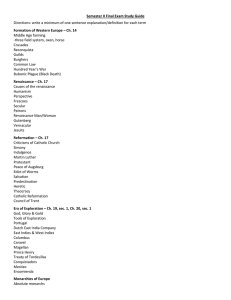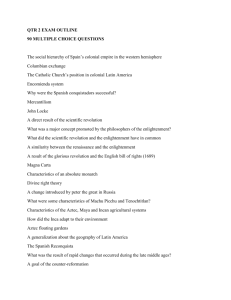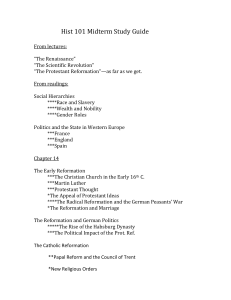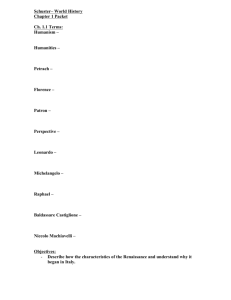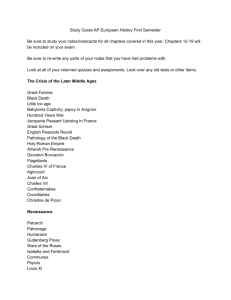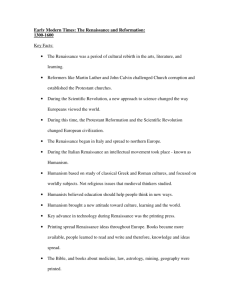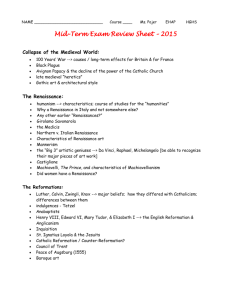World Midterm Review 2014
advertisement
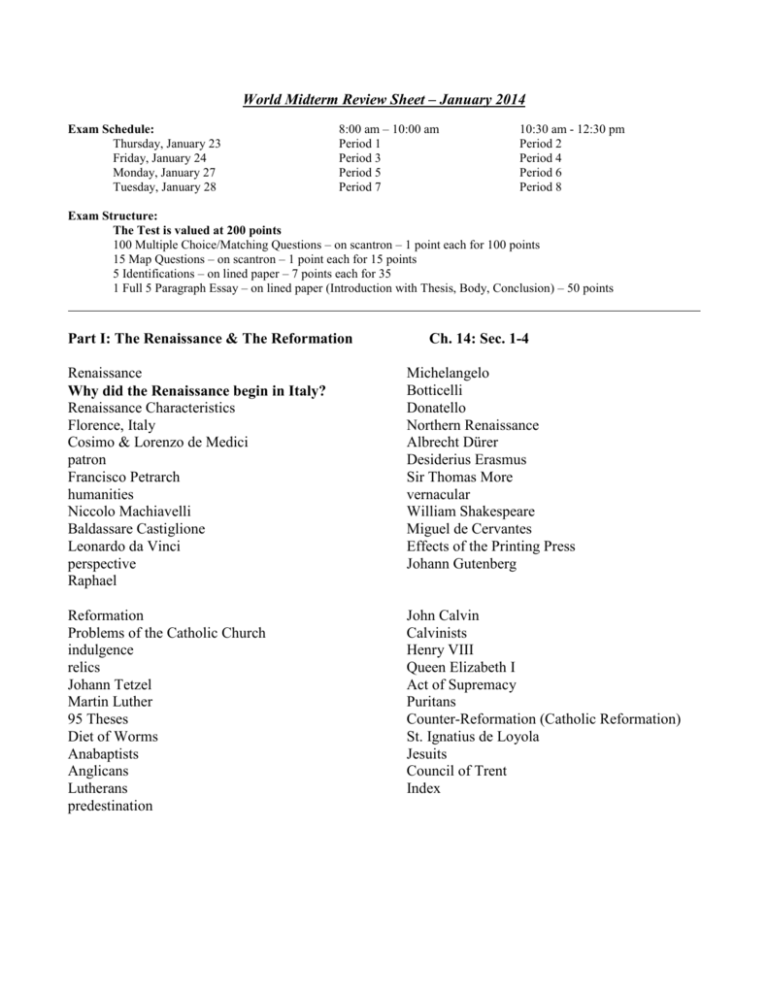
World Midterm Review Sheet – January 2014 Exam Schedule: Thursday, January 23 Friday, January 24 Monday, January 27 Tuesday, January 28 8:00 am – 10:00 am Period 1 Period 3 Period 5 Period 7 10:30 am - 12:30 pm Period 2 Period 4 Period 6 Period 8 Exam Structure: The Test is valued at 200 points 100 Multiple Choice/Matching Questions – on scantron – 1 point each for 100 points 15 Map Questions – on scantron – 1 point each for 15 points 5 Identifications – on lined paper – 7 points each for 35 1 Full 5 Paragraph Essay – on lined paper (Introduction with Thesis, Body, Conclusion) – 50 points Part I: The Renaissance & The Reformation Ch. 14: Sec. 1-4 Renaissance Why did the Renaissance begin in Italy? Renaissance Characteristics Florence, Italy Cosimo & Lorenzo de Medici patron Francisco Petrarch humanities Niccolo Machiavelli Baldassare Castiglione Leonardo da Vinci perspective Raphael Michelangelo Botticelli Donatello Northern Renaissance Albrecht Dürer Desiderius Erasmus Sir Thomas More vernacular William Shakespeare Miguel de Cervantes Effects of the Printing Press Johann Gutenberg Reformation Problems of the Catholic Church indulgence relics Johann Tetzel Martin Luther 95 Theses Diet of Worms Anabaptists Anglicans Lutherans predestination John Calvin Calvinists Henry VIII Queen Elizabeth I Act of Supremacy Puritans Counter-Reformation (Catholic Reformation) St. Ignatius de Loyola Jesuits Council of Trent Index Part II: Exploration, Colonization, & the Commercial Revolution Ch. 15 Sec. 1, 3 & 4 / Ch. 16 Sec. 1-5 Why didn’t Ming continue to explore? Aztecs Motivations for European exploration Montezuma Portugal Spain astrolabe caravel cartographers dead reckoning Prince Henry the Navigator Bartholomeu Dias Vasco de Gama Pedro Cabral Isabella & Ferdinand Christopher Columbus Treaty of Tordesillas Line of Demarcation Ferdinand Magellan circumnavigation Northwest Passage John Cabot Jacques Cartier Henry Hudson Sir Francis Drake Dutch East India Company British East India Company China and Japan’s reaction to Europeans Tokugawa Japan Hernan Cortés Incas Francisco Pizarro Atahualpa colony viceroy Council of the Indies encomienda Bartolome de las Casas plantation Life in the Spanish colonies New France The 13 English Colonies Slave trade Middle passage West Indies The Columbian Exchange Commercial Revolution disease – small pox Triangular Trade inflation capitalism entrepreneurs joint-stock company mercantilism Part III: The Age of Absolutism, Constitutionalism, the Scientific Revolution & Enlightenment Ch. 17 Sec. 1-5 / Ch. 14 Sec. 5 / Ch. 18 Sec. 1 & 2 Reasons for why Spanish Power declined English Civil War 1600s Cavaliers Maria Theresa of Austria Roundheads Hapsburgs Oliver Cromwell Prussia “New Model Army” Fredrick William II the Great Commonwealth Peter the Great The Restoration Westernization Charles II warm-water port James II Catherine the Great Glorious Revolution Constitutionalism William and Mary Tudor Monarchs English Bill of Rights Parliament habeas corpus James I limited monarchy Charles I Scientific Revolution René Descartes Francis Bacon Scientific Method hypothesis Ptolemy geocentric Nicolaus Copernicus heliocentric Tyco Brahe Johannes Kepler Galileo Galilei telescope Sir Isaac Newton gravity Laws of Motion Enlightenment Natural Laws Thomas Hobbes John Locke Natural Rights Baron de Montesquieu separation of Power checks and balances Philosophes Voltaire Denis Diderot The Encyclopedia Jean-Jacques Rousseau salon Wollstonecraft physiocrat Adam Smith laissez faire Part IV: The French Revolution & Napoleon See chapter review sheet Ch. 19 Sec. 1-5 Maps (you should be able to locate the following on a map) Major countries/civilizations that we’ve studied France, England, Russia, Spain, Holy Roman Empire, Italy, Greece, China, Japan Arabian Peninsula Trade Routes – Silk Road Caribbean Islands South America: Incan and Aztec Empires Colonial Settlements of the New World European Voyages of Exploration Routes – Columbus, Magellan, Diaz, da Gama Possible Essays: - Introduction paragraph Thesis statement which addresses the question (last sentence of the introduction) 3 or more body paragraphs which use factual, historical information in support A conclusion paragraph which summarizes the main points of your essay 1. Define the term Renaissance and its major characteristics. Use examples. Then identify and explain at least THREE reasons why it began in the Italian city-states. EVALUATE which cause is the most influential. 2. Define the term Protestant Reformation. Explain key causes of the Protestant Reformation. Who were the major figures involved in this movement? What were their beliefs? How did the Protestant Reformation change the religious face of Europe? 3. Define the Columbian Exchange. Use at least THREE specific examples to explain how the Columbian Exchange helped both the Old World and the New World. Then using at least THREE specific examples, explain how the Columbian Exchange harmed both the Old World and the New World. 4. Define Constitutional Monarchy. Then discuss how THREE of the following lead to the development of England’s Constitutional Monarchy. Reign of Charles I Oliver Cromwell’s Commonwealth James II Glorious Revolution / English Bill of Rights Cabinet & Prime Minister 5. Make three comparisons using TWO of the following Absolute monarchs. Phillip II of Spain Louis XIV of France Peter the Great of Russia Be sure to make meaningful comparisons for THREE of the following topics: religion society foreign policy economy culture 6. Was Napoleon Bonaparte FOR or AGAINST the ideals of the French Revolution as Emperor of France? Choose one side and argue it citing THREE main reasons.

